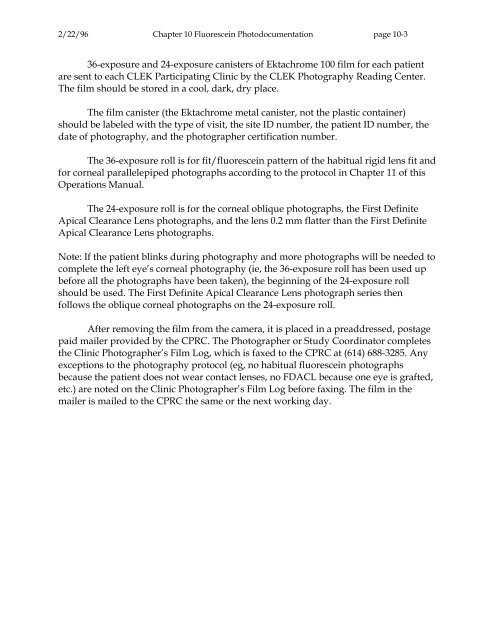OM t of c.iii - Vision Research Coordinating Center - Washington ...
OM t of c.iii - Vision Research Coordinating Center - Washington ...
OM t of c.iii - Vision Research Coordinating Center - Washington ...
Create successful ePaper yourself
Turn your PDF publications into a flip-book with our unique Google optimized e-Paper software.
2/22/96 Chapter 10 Fluorescein Photodocumentation page 10-3<br />
36-exposure and 24-exposure canisters <strong>of</strong> Ektachrome 100 film for each patient<br />
are sent to each CLEK Participating Clinic by the CLEK Photography Reading <strong>Center</strong>.<br />
The film should be stored in a cool, dark, dry place.<br />
The film canister (the Ektachrome metal canister, not the plastic container)<br />
should be labeled with the type <strong>of</strong> visit, the site ID number, the patient ID number, the<br />
date <strong>of</strong> photography, and the photographer certification number.<br />
The 36-exposure roll is for fit/fluorescein pattern <strong>of</strong> the habitual rigid lens fit and<br />
for corneal parallelepiped photographs according to the protocol in Chapter 11 <strong>of</strong> this<br />
Operations Manual.<br />
The 24-exposure roll is for the corneal oblique photographs, the First Definite<br />
Apical Clearance Lens photographs, and the lens 0.2 mm flatter than the First Definite<br />
Apical Clearance Lens photographs.<br />
Note: If the patient blinks during photography and more photographs will be needed to<br />
complete the left eye’s corneal photography (ie, the 36-exposure roll has been used up<br />
before all the photographs have been taken), the beginning <strong>of</strong> the 24-exposure roll<br />
should be used. The First Definite Apical Clearance Lens photograph series then<br />
follows the oblique corneal photographs on the 24-exposure roll.<br />
After removing the film from the camera, it is placed in a preaddressed, postage<br />
paid mailer provided by the CPRC. The Photographer or Study Coordinator completes<br />
the Clinic Photographer’s Film Log, which is faxed to the CPRC at (614) 688-3285. Any<br />
exceptions to the photography protocol (eg, no habitual fluorescein photographs<br />
because the patient does not wear contact lenses, no FDACL because one eye is grafted,<br />
etc.) are noted on the Clinic Photographer’s Film Log before faxing. The film in the<br />
mailer is mailed to the CPRC the same or the next working day.
















